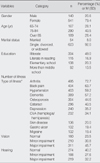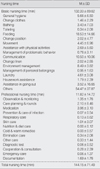Abstract
Purpose
The purposes of this study were to explore the functional status of elderly residents and to analyze time use, and finally identify factors to predict nursing care needs in relation to functional status and health related variables. Methods: In this study a descriptive-correlational design was used. Functional status of participants was obtained through interviews, and nursing care time was examined using a 1 min time-motion study with a standardized instrument developed by Korea Long-Term Care Planning Committee (2005).
Methods
In this study a descriptive-correlational design was used. Functional status of participants was obtained through interviews, and nursing care time was examined using a 1 min time-motion study with a standardized instrument developed by Korea Long-Term Care Planning Committee (2005).
Results
The mean total functional score was 65 (range 28-125) and mean total nursing care time was 144.15 min per day. There were significant positive relationships between total nursing care time, marital status, back pain, dementia, and vision impairment. Multiple regression analyses showed that a liner combination of number of illnesses, types of primary disease, ADL, IADL, cognitive function, nursing demand, and rehabilitation demand explained 42.8% of variance of total nursing time. ADL (β=-.533) was the most significant predictor of nursing service need.
Figures and Tables
References
1. Banaszak-Holl J, Fendrick AM, Foster NL, Herzog AR, Kabeto MU, Kent DM, et al. Predicting nursing home admission: Estimates from a 7-year follow-up of a nationally representative sample of older Americans. Alzheimer Disease and Associated Disorders. 2004. 18:83–89.
2. Björkgren MA, Fries BE, Häkkinen U, Brommels M. Case-mix adjustment and efficiency measurement. Scandinavian Journal of Public Health. 2004. 32:464–471.
3. Capenter GI, Ikegami N, Ljunggren G, Carrillo E, Fries BE. RUG-III and resource allocation: Comparing the relationship of direct care time with patient characteristics in five countries. Age and Aging. 1997. 26:61–65.
4. Carpenter I, Perry M, Challis D, Hope K. Identification of registered nursing care of residents in English nursing homes using the Minimum Data Set Resident Assessment Instrument (MDS/RAI) and Resource Utilisation Groups version III (RUG-III). Age and Ageing. 2003. 32:686.
5. Chang HS. Analysis of hospital services for elderly inpatients. Journal of Korea Society of Quality Assurance in Health Care. 2000. 7:18–31.
6. Gibson MJ, Verma S. Just Getting By: Unmet Need for Personal Assistance Services Among Persons 50 or Older with Disabilities. 2006. Washington, DC: AARP Public Policy Institute.
7. Harrington C. Nurse staffing in nursing homes in the United States: Part II. Journal of Gerontological Nursing. 2005. 31(3):9–15.
8. Harrington C, Zimmerman D, Karon SL, Robinson J, Beutel P. Nursing home staffing and its relationship to deficiencies. Journal of Gerontology. 2000. 55:278–287.
9. Jung KH, Suk JE, Sunwoo D, Kim CW, Lee TW, Lee TJ, et al. Development of targeting and fee systems for long-term care. 2005. Seoul: Korea Institute for Health and Social Affairs.
10. Kim CW, Lee GO, Lee YW, Won JW, Yeon BK, Lee TW, et al. Development of an evaluation tool for long-term care system. 2004. Seoul: Korea Institute for Health and Social Affairs.
11. Kim EK. Care time of elderly in long-term care facilities. Journal of Korean Academy of Nursing Administration. 2003. 9:353–364.
12. Kim EY. Economic evaluation of long term care service. 2002. Seoul: Seoul National University;Unpublished doctoral dissertation.
13. Kim HC. A study on possible variations of senior care facilities after the enforcement of long-term senior care insurance act. 2008. Seoul: Kyunghee University;Unpublished master's thesis.
14. Korea Institute of Health & Welfare. National long-term care survey for elderly living status and welfare needs. 2005. Seoul National Ministry of Health & Welfare.
15. Korea National Statistical Office. Census of population in Korea on 2007 year. 2007. Seoul: Author.
16. Kovner CT, Mezey M, Harrington C. Who cares for older adults? Workforce implications of an aging society. Health Affairs. 2002. 21:78–89.
17. Lee J. The relationship of functional status and resource utilization among elderly patients-Focused on care times among elderly patients in geriatric hospitals-. 2005. Seoul: Yonsei University;Unpublished master's thesis.
18. Lee JJ. Application of RUG-III for long-term care elderly patients. 1999. Seoul: Yonsei University;Unpublished doctoral dissertation.
19. Lee SH. The determinants of nursing home quality indicators: A multilevel analysis. Journal of Korean Academy of Nursing Administration. 2006. 12:473–481.
20. Lee SH, Kim SR, Kim SM, Kim EK, Park SK, Oh JH. A study on supply strategy of long-term care facility and special beds. 2001. Seoul: Korea Health Industry Development Institute.
21. Long-Term Care System Information. National Long-Term Care Agency. 2008. Retrieved October 23, 2008. from http://www.longtermcare.or.kr/portal/site/nydev/MENUITEM.
22. Ministry of Health & Welfare. Evaluation of long-term care facilities. 2005. Unpublished manuscript.
23. National Long-Term Care Planning Committee. Development of targeting and cost systems for long-term care. 2005. Seoul: Korea Institute of Health and Social Affairs.
24. Nordberg G, Wimo A, Jönsson L, Kåreholt I, Sjölund BM, Lagergren M, et al. Time use and costs of institutionalised elderly persons with or without dementia: Results from the Nordanstig cohort in the Kungsholmen Project -A population based study in Sweden. International Journal of Geriatric Psychiatry. 2007. 22:639–648.
25. Phillips CD, Hawes C. Care provision in housing with supportive services: The importance of care type, individual characteristics, and care site. Journal of Applied Gerontology. 2005. 24:55–67.
26. Sung KW, Shin IH, Lee KH, Kwan KH. Content analysis of the nurses working in the free elderly home and nursing home. Journal of Korean Gerontological Nursing. 2005. 7:7–19.
27. Sunwoo D, Jung KH, Oh YH, Cho AJ, Suk JE. Survey need of long-term care and politic strategy. 2001. Seoul: Korea Institute for Health and Social Affairs.
28. Sunwoo D, Suk JE, Kim CW, Lee TW, Jung HS, Lee MJ, et al. Korea long-term care demonstration project evaluation. 2006. Seoul: Korea Institute for Health and Social Affairs.
29. Tabachnick BG, Fidell LS. Using multivariate statistics. 1989. New York, NY: Harper Collins Publishers, Inc..
30. US Congressional Budget Office. Long-term care for the elderly and the disabled: Budget issue paper. 1997. Washington, DC: US Government Printing Office.
31. Wolinsky FD, Johnson RJ. The use of health services by older adults. Journal of Gerontology. 1991. 46:345–357.
32. Woo J, Ho C, Yu M, Lau I. An estimate of long-term care needs and identification of risk factors for institutionalization among Hong Kong Chinese aged 70 years and over. Journal of Gerontoloy. 2000. 55:64–69.




 PDF
PDF ePub
ePub Citation
Citation Print
Print









 XML Download
XML Download